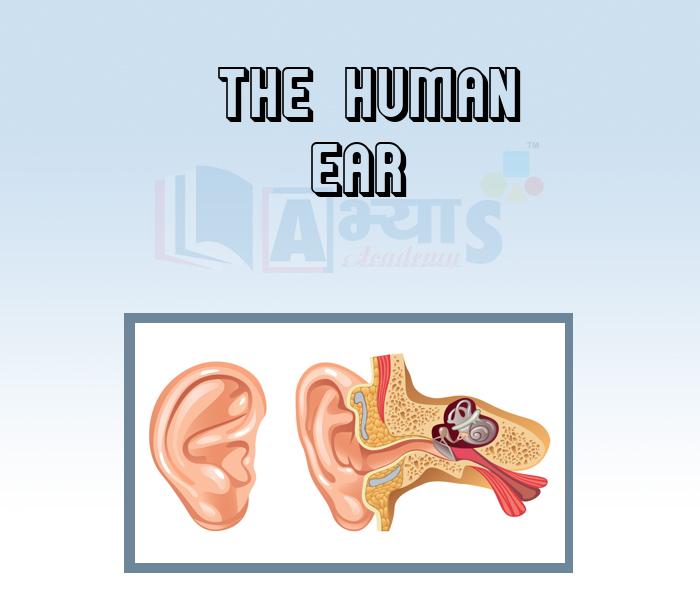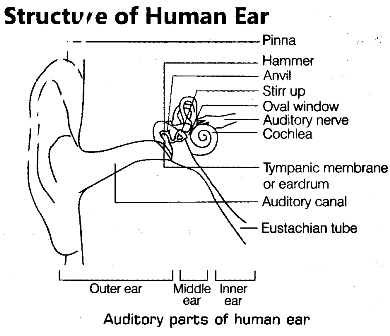The Human Ear













The Human Ear
The Human Ear: The ears are the sense organs which helps us in hearing sound. It allows us to convert pressure variations in air with audible frequencies into electric signals which travel to the brain via auditory nerve. The ear consists of three compartments: Outer ear, Middle ear and Inner ear.
1. Outer Ear: The part of ear which we see outside the head is outer ear. It consists of a broad part pinna and about 3 cm long passage ear canal. At the end of ear canal, a thin, elastic and circular membrane, eardrum is present, which is also called tympanum or tympanic membrane.
2. Middle Ear: Contains three small bones- hammer, anvil and stirr up, which are connected with each other. One end of hammer is touching the eardrum and the free end of stirr up is touched to oval-window of inner ear. The lower part of middle ear has a narrow tube called eustachian tube going to the throat. It ensures that the air pressure inside the middle ear is the same as that on the outside.
3. Inner Ear: It has a coiled tube, cochlea. One side of cochlea is connected to middle ear through elastic membrane over the oval window. A liquid is filled in cochlea, which contains nerve cells that are sensitive to sound. The other side of cochlea is connected to auditory nerve going into the brain

Which of the following are correct : (a) Auditory canal is a part of middle ear. (b) The outer ear is the cavity with three important ear bones. (c) The middle ear is the cavity with three important ear bones. | |||
| Right Option : C | |||
| View Explanation | |||
For human ears, the audible range is ____________Hz to _______________Hz. | |||
| Right Option : C | |||
| View Explanation | |||
Which of the following are correct : (a) The part of the outer ear that is visible to us is called pinna. (b) The middle ear is the cavity with three important ear bones. (c) In the inner ear, the pressure variations are turned into electrical signals by the chochlea. | |||
| Right Option : D | |||
| View Explanation | |||
Students / Parents Reviews [10]
A marvelous experience with Abhyas. I am glad to share that my ward has achieved more than enough at the Ambala ABHYAS centre. Years have passed on and more and more he has gained. May the centre flourish and develop day by day by the grace of God.

Archit Segal
7thAbhyas is a complete education Institute. Here extreme care is taken by teacher with the help of regular exam. Extra classes also conducted by the institute, if the student is weak.

Om Umang
10thMy experience with Abhyas is very good. I have learnt many things here like vedic maths and reasoning also. Teachers here first take our doubts and then there are assignments to verify our weak points.

Shivam Rana
7thIt was good as the experience because as we had come here we had been improved in a such envirnment created here.Extra is taught which is beneficial for future.

Eshan Arora
8thIt was a good experience with Abhyas Academy. I even faced problems in starting but slowly and steadily overcomed. Especially reasoning classes helped me a lot.

Cheshta
10thOne of the best institutes to develope a child interest in studies.Provides SST and English knowledge also unlike other institutes. Teachers are co operative and friendly online tests andPPT develope practical knowledge also.

Aman Kumar Shrivastava
10thAbout Abhyas metholodology the teachers are very nice and hardworking toward students.The Centre Head Mrs Anu Sethi is also a brilliant teacher.Abhyas has taught me how to overcome problems and has always taken my doubts and suppoeted me.

Shreya Shrivastava
8thIt has a great methodology. Students here can get analysis to their test quickly.We can learn easily through PPTs and the testing methods are good. We know that where we have to practice

Barkha Arora
10thMy experience was very good with Abhyas academy. I am studying here from 6th class and I am satisfied by its results in my life. I improved a lot here ahead of school syllabus.

Ayan Ghosh
8thMy experience with Abhyas academy is very good. I did not think that my every subject coming here will be so strong. The main thing is that the online tests had made me learn here more things.
